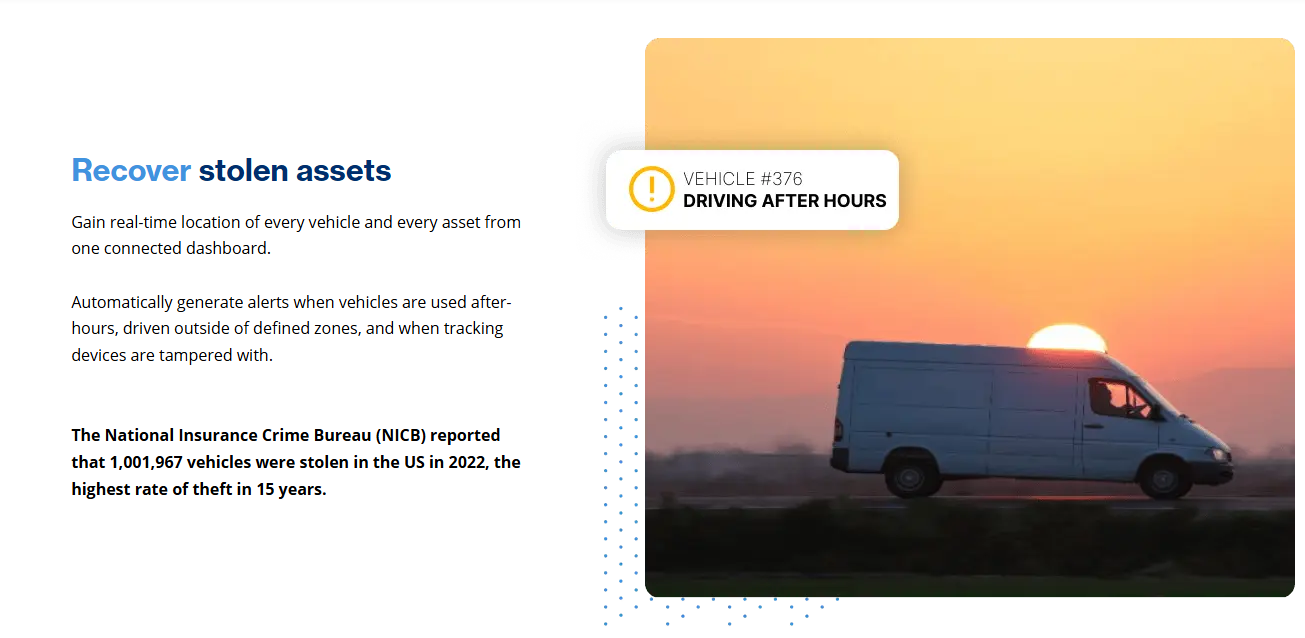Sponsored by OneStep GPS
How to choose a fleet tracking system
We list the important factors to consider when choosing a fleet tracking system

A GPS fleet tracking system is a vital addition to any organization that manages an array of trucks, vans, or cars, but these complex products need careful consideration – get it right and you’ll revolutionize your organization, but get it wrong and you could cause serious issues.
The right fleet management system will help your organization deliver more efficient routes, reduced operational costs, safer conditions for road users, and improved productivity.
But if you don’t get a product that’s well-suited to your organization, it won’t integrate with existing systems, it won’t help you save time or money, and it won’t lead to satisfied customers or end-users.
There’s plenty to consider, too. Fleet management solutions include in-depth GPS and telematics abilities, and they integrate with other crucial software and hardware products. They work on multiple platforms, and they’re required to get the job done accurately for industries as varied as logistics, the emergency services, vehicle rental, and education.
It all needs to be appropriately considered if you’re going to invest in a fleet management solution that will have a positive impact on your organization. And if you’re unsure about the factors you need to weigh up, read on – we’ve got you covered.
OneStep GPS is offering $10 off per vehicle to all TechRadar readers
As a TechRadar reader, you’re in luck, since you can get a $10 discount per vehicle on your next OneStep GPS purchase. What’s more, you will also enjoy a 100-day full money-back guarantee, as well as free shipping and lifetime device warranty.
Figure out the fleet
Before you even start looking at different fleet management solutions, the first step needs to be considering the fleet itself, because its size and composition will have a significant influence on your eventual solution.
The type of product you need will vary dramatically if you’ve got a fleet of cars rather than a fleet of huge delivery trucks, and vice versa – and the size of the fleet will be worth consideration, too.
Sign up to the TechRadar Pro newsletter to get all the top news, opinion, features and guidance your business needs to succeed!
If you’ve got a small and straightforward fleet, for instance, then real-time tracking and route optimization help you keep things moving without the need for more full-time staff. Mobile access will be necessary for managers with busy, varied jobs, and maintenance reminders will prevent downtime and costly repairs.
With a moderate fleet, automated dispatch and job assignment features will be important as your organization scales upwards, and fuel tracking and usage reports could help the business reduce costs and spot inefficiencies.
The largest fleets will want custom dashboards, driver performance monitoring, and analytics to deliver bespoke insights.
Larger fleets will also need scalable maintenance scheduling, integration with other business systems like CRM and payroll systems, and tools to ensure regulatory compliance.
The best way to navigate this stage of the process is to conduct an audit of your fleet’s vehicles and size, and to consider how you plan to alter the fleet in the future.
At this time, it’s also worth considering the key pain points and issues that your organization is experiencing, because this can help you choose where you need to focus when picking a potential product.

Focus on the features
Once you have a comprehensive audit of your fleet – and how your fleet will look in the future – it’s time to start identifying which features you need from your next fleet management solution.
This is a crucial part of the process. Fleet management systems can include a bewildering array of features, no single product does everything well, and you’ll have to consider what’s important in your organization.
If you work in logistics and delivery, for instance, you’ll need to find a fleet management system that prioritizes route optimization, real-time GPS tracking, and driver behavior, and a system that offers integration with proof-of-delivery software. That’s key if you want to deliver packages effectively and ensure a good customer experience.
But if you’re in healthcare, you may want a solution with temperature monitoring, real-time tracking, and compliance reporting to keep sensitive cargo safe and ensure that the organization complies with strict industrial regulations.
For the utilities industry, it’s important to have job scheduling, mobile access, and two-way communication to maximize technician productivity. And if you’re in construction, you may be able to eschew real-time tracking for a more affordable periodic system, because you don’t need 24/7 reporting.
And in education, you’ll want more stringent driver behavior monitoring, robust geofencing abilities, and real-time tracking.
None of these industry-specific requirements are strict – you’ll be the best judge of what you need. But these examples show that different industries will have different requirements, and you’ll need to work out what you need from your system before taking the plunge.
Another important step here: evaluate which features are absolute must-haves from your next upgrade, and which features would be nice, but aren’t essential.

Think about deployment
You will hopefully have several options that tick the right boxes when it comes to your fleet and feature requirements, but a complex fleet management system will need to work effectively to make a positive impact.
To ensure that happens, evaluate the ways that various fleet management providers will support your organization: some will be better than others when it comes to installation, configuration, and deployment, for instance, and others will offer more comprehensive support packages.
You may want 24/7 phone support, perhaps, or a slate of staff training sessions to get colleagues up to speed on your new system. Not every provider will have this capability.
Similarly, the best fleet management systems have smart integrations with other software suites, like CRM tools, payroll, and scheduling systems, or maintenance utilities. Your fleet management software shouldn’t operate in a silo – so if you want it to integrate with other key business tools, make sure that’s an option before taking the plunge.
You’ll also need to make sure that the software and management dashboards are compatible with the PC, laptop, and mobile devices in use across your organization.
Similarly, make sure that the hardware used by any future fleet tracking system will actually work with your vehicles. It’s no good investing in a system that won’t connect properly to your fleet.
And, finally, make sure that any potential fleet management system is compliant with the various regulations, certifications, and laws that you must adhere to in order to do business effectively.
Being non-compliant can cause reputational damage, financial losses, and operational issues, so any new software in a business or non-profit organization must adhere to industrial compliance standards.
Crunch the numbers
By this point, you should have figured out which features you need for the kind of fleet you’re running – but that means it’s time to start thinking about cost.
Most fleet management systems include an initial, up-front cost for hardware, software, installation, and training, so take some time to find out how much that would cost for your fleet.
That’s not where the expense will potentially stop, though. Lots of fleet management solutions will charge monthly or annual subscription fees based on the size and makeup of your fleet, or the features and modules that you include in your bespoke fleet management solution.
Your costs can also vary depending on the level of support you include with the product, if you’d like to integrate the product with other software that’s used in your organization, and if you want custom dashboards or workflows.
Take some time at this point to consider how the cost could rise in the future if your fleet increases in size or complexity, too.
It pays to be careful here, and to really read the fine print – you don’t want to be caught out by hidden fees or clauses in contracts, and you don’t want to end up without a feature you really need.
Once the product pricing has been calculated, think about the Return on Investment (ROI) that a fleet management system will generate for your organization.
A good fleet management system will help your organization reduce fuel costs, repair expenses, and operational downtime, while improving operational efficiency at the same time.
You can also generate good ROI by avoiding regulatory fines, reducing insurance premiums, and using your fleet more effectively – and, ultimately, by improving customer satisfaction and growing your business.
It can be difficult to evaluate ROI when you haven’t yet invested in a fleet management system, but start by auditing your current costs and identifying the key pain points you’d like to fix. You can use industry benchmarks and data from fleet management providers to research potential savings and calculate the Total Cost of Ownership (TCO) of your new product.
If your ROI will eventually outpace your TCO, then you’ve got the start of a solid business case for investing in a new fleet management solution.
Compare and contrast
You’ve come a long way in your fleet management journey already, but at this point, it’s time to start narrowing down the options.
It’s likely at this point that you have a handful of fleet management solutions that could, potentially, work well for your organization.
But now you know all about their features, costs, and return on investment, you should have a clearer picture of which ones are viable contenders for you and which ones you can leave at the roadside due to a lack of appropriate features or a high cost.
If you’ve got a shortlist of potential options, start talking to them: they should all have case studies with real-world evidence of the impact their solutions can have, and many should be able to arrange demonstrations to illustrate how the software could benefit your organization.
By the time you’re ready to make a choice, you should be able to create an internal business case for a new fleet management solution with vendor comparisons, features, how the solution would address pain points, and its TCO vs ROI.
You should also be able to produce an implementation plan to illustrate how the new solution would be integrated into your systems and onboarded with your staff.
It’s time to invest, then, and time to revolutionize your operations with a new fleet management solution. There’s only one thing for it – we’ll see you on the road!
Mike has worked as a technology journalist for more than a decade and has written for most of the UK’s big technology titles alongside numerous global outlets. He loves PCs, laptops and any new hardware, and covers everything from the latest business trends to high-end gaming gear.
